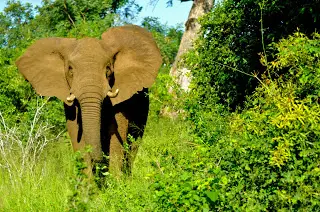Last week I posted a video that gave us an inside look at the efforts of poachers in Africa to get their hands on elephant tusks which are then sold on the black market. This trade has risen to such heights in recent years, that it now threatens the wild elephant population, which could go extinct in our lifetimes. Now, National Geographic has followed that video up with an interactive online article that takes us through how the ivory trade works, and how the value of those tusks increases as it makes its way through the supply chain.
To tell this story, Nat Geo created fake elephant tusks that contain GPS trackers and sensors that are capable of registering no only their location, but surrounding conditions as well. They then planted those fake tusks with poachers, and followed their progress across Africa starting in the Central African Republic, a country that has seen its elephant population intensely targeted.
The tusks then traveled along a known smuggling route that also happens to follow a region where the Lord’s Resistance Army – led by Joseph Kony – operates almost with impunity. At one point, the GPS-enabled tusks are transferred into South Sudan, before entering Kafia Kingi, a disputed region that is currently controlled by Sudan. At this point, they have traveled 483 km (300 miles) to be a part of the poacher’s inventory.
But the journey is far from over. After spending three weeks in Kafia Kingi, the tusks go back on the move heading north before reaching Ed Daein in Sudan. At this point, they have traveled more than 900 km (560 miles), and are currently either sitting in a building or are buried under ground. Researchers are waiting for the GPS signal to go active again so they can discover the next stage of the journey toward buyers most likely in Asia.
The article then goes on to explain how the price of poached ivory rises as it passes through the supply chain, starting out at a value as low as $66/pound and rising to as much as $4630/pound as it makes its way out to the Asian markets.
This eye-opening report does a good job of showing the flow of ivory through Africa, and then out to the rest of the world. It is a sobering look at what has become a major problem that could ultimately lead to the demise of wild elephants in Africa. Poaching accounts for the death of more than 30,000 of those creatures in a given year, and it is a practice that simply has to end. How we get to the point where it doesn’t happen any longer is the real challenge, but it involves shutting down the demand for ivory in places across the world, including the U.S. and China.
As someone who has seen elephants in the wild throughout Africa, it is unfathomable that they are killed in such high numbers just to claim their tusks. Hopefully we can reverse this trend in the years ahead, and we’ll see the end of poaching in our lifetime, rather than the extinction of these animals.
- Gear Review: The Xero Scrambler Mid is an Ultralight Hiking Shoe for Spring - March 1, 2023
- Gear Review: Yeti Roadie 48 Wheeled Cooler - August 18, 2022
- Kristin Harila Continues Pursuit of 8000-Meter Speed Record - August 16, 2022
